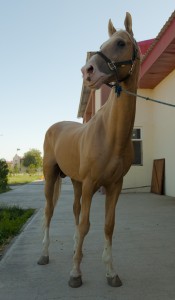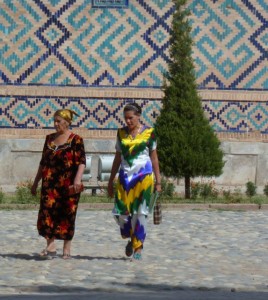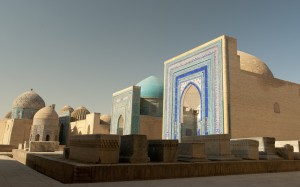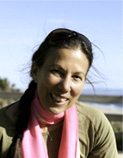Thank goodness the second Turkman agency facilitator is with us, in what I’ve taken to calling our “guidemobile.” I expect a long palaver to ensue, with police, and forms, much gesticulating, growling, headshaking and frowning of black eyebrows. Not so. The agency makes it all go away, assuring the offended party that they will handle things. In return for this, we part with $400, a moderate sum considering the damage done by Brunhilde (I want to make clear this was all her doing…).
Off we go through town, where I spy a huge poster that seems to advertise horse racing. My brain, still in shock from all the dazzling whiteness clicks into gear, connecting that poster with the name of our hotel’s restaurant: Akhal Teke. I have seen a photo of this legendary horse, with a caption that it was a Russian breed. It dawns on me that back then, Turkmenistan was part of the USSR, so no one cared that it was actually a Turkman horse. Now it’s been claimed by its rightful breeders and they are bursting with pride over it.
“I must see the Akhal Teke horses before we leave!” I half beg, half plead to Yagshi, the young facilitator who has already proved himself so useful. Bernard shakes his head at me, indicating I should not ask for something that’s not on the program. But actually, nothing’s on the program since all we are doing is driving from one city to the next. So I persist with my begging and pleading. Well, defying my expectation that he would get all Soviet on me, Yagshi got right on the phone . A couple minutes later and he’s directing us to the nearby hippodrome, where there are usually plenty of Akhal Teke to see, because they’re used as race horses.
We find our way into a huge and of course spectacular race track complete with its own array of marble buildings., and drive right up to the stables. No one stops us. Not only are they not concerned we’re there, when we find the stable manager he’s delighted to bring out one stallion after another to show us. This chunk of a man in denim work shirt, baggy jeans and plastic sandals, rubs a large hand over his stubbly head and asks me,”New Jersey?” as he halters a bay, a grey and a palomino. Each displays the classic ungainly conformation of the breed, with a narrow chest, skimpy hindquarters, long back and stork-like eggs so long it looks like they’re on stilts. They’re the equine version of the greyhound, bred for endurance and able to go without water for several days. They all stand 16 hands high, with a noble head, large eye, long neck. Until the Russians took over, the breeding pedigree was done orally. It is presumed that one of the 3 foundation stallions of the Thoroughbred breed was an Akhal Teke, though today only about 3,500 of the breed remain.
Outside the stable, we discover all the gold horses which the breed is particularly famous for. These are buckskins, beige with black legs, mane and tail, and everyone has that mysterious gold bloom to its coat which makes them glint and glitter with a metallic sheen in the sun. They’re being worked by the President’s elite drill team, who are polishing their routine for the Oct. 27 independence celebrations. By the way, the breed names combines the Akhal region in which Ashgebad is located, and the Teke tribe in that region that originally bred these horses.
I was pretty satisfied with this unexpected bonus visit, but then a drill master came over a man with a crumpled face missing many teeth, dressed in soft blue cotton trousers tucked into calf-high black leather boots. Jumping off his dark bay stallion he offered us the reins. Bernard went first, and then I rode him. the drill master kept urging us to take him over one of the 3.5-foot jumps, but this we declined, especially as I was wearing sandals. But let’s be honest, I doubt I’d have gone over one of those jumps even if I was wearing armor. That ended our surprising morning in Ashgebad, a place that for obvious reasons I will now never forget.

A final, brief word about national dress. In Turkmenistan, the women wear ankle-length dresses in lovely, gay fabrics, perhaps with a bit of embroidery around the neck. The dresses are slender, though not form-fitting, and very flattering.
In Uzbekistan, where I am now, the national dress is more like a muumuu with a scoop neck. It billows at the calf, shapeless, with the cuffs of pantaloons peeking out below.
What’s astonishing in Uzbekistan are the gaudy patterns in clashing neon colors like lime, magenta and lemon, and the fabric which is often velveteen with sparkles and gold threads. Women float along like brash, glinting dirigibles.
Below are more photos from Samarkand, Uzbekistan…stay tuned for my next dispatch!
-Dina















